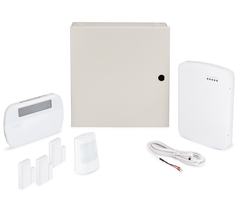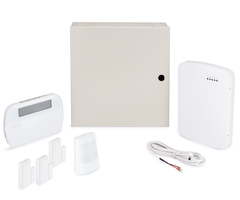Telguard TG-7-V
Verizon Commercial Intrusion LTE Cat-M1 Universal Alarm Communicator
Description
The Telguard TG-7-V is a commercial-rated burglary alarm communicator that uses the Verizon LTE Cat-M1 cellular network. It can be powered by its own supplied UL plug-in transformer (12 VAC 10VA) or by the alarm panel. When using its own transformer, there is a charging circuit for a backup battery (not supplied).
Telguard provides a versatile line of cellular communicators that can work with any alarm panel that normally communicates to a central station using a POTS (Plain Old Telephone Service) phone line. The Telguard TG-7-V can monitor the existing phone line connection at the panel, and if the phone line is cut or otherwise becomes disabled, then the TG-7-V listens for the alarm panel to dial out, and captures that signal then transmits it via the Verizon LTE Cat-M1 network. That's one way this communicator can work.
Another way the Telguard TG-7-V can be used is by simply replacing the phone line. If there is no landline phone service in the location to be monitored, then the TG-7-V is connected to the connector or terminals on the alarm panel where a phone line would normally be wired. The TG-7-V provides a dial-tone to the alarm panel, emulating a phone connection. When the panel needs to transmit a signal, it simply dials out, the TG-7-V captures the signal, and then transmits it to the monitoring station, via Telguard and the Verizon network. To the alarm panel, it seems as though it just sent a signal through a phone line.
The Telguard TG-7-V can support the following dialer formats used by the alarm panel. That means that any UL/ULC/cUL Listed alarm panel that supports, and is programmed to transmit signals using one of these formats, can work with the TG-7-V:
- Pulse Formats:
- 3+1 pulse; 10pps, Double Round, 1400 Hz ack
- 3+1 pulse; 20pps, Double Round, 2300 Hz ack
- 3+1 pulse; 40pps, Double Round, 2300 Hz ack
- 4+2 pulse; 20pps, Double Round, 1400 Hz ack
- 4+2 pulse; 20pps, Double Round, 2300 Hz ack
- 4+2 pulse; 40pps, Double Round, 2300 Hz ack
- Contact ID
- Modem IIe/IIIa2/4
- SIA2 (SIA-DC-03 level 2 release at 300 baud)
- Sonitrol
- DMP
- Hexadecimal account numbers can be used with 3+1 or 4+1 formats as well as Contact ID and Modem (4 or 10 digits for Contact ID, 4 digits for Modem.
Contact ID and SIA2 are the most commonly used communication formats and provide the monitoring station with more information about the alarm signal being received than most of the other formats listed above. Whenever possible, we recommend the use of one of these formats.
The Telguard TG-7-V has numerous self-monitoring features. It has two (2) relay outputs (STC1, and STC2) that can be wired into zones on the alarm panel so that if the communicator develops an issue, it can notify the user through the panel zone or zones. The TG-7-V can supervise for the following conditions:
- Line Fault Condition (LFC): This option is only applicable when an actual phone line is in use, and the TG-7-V is being used as a backup for it. If on-hook phone line voltage drops below 20VDC, then a line fault condition is displayed. The System Trouble Condition LED (STC LED) will flash three (3) times and the STC relay will trip after a programmable delay period. Both the LED and relay will restore automatically when the condition clears.
- No Service Condition (NSC): This occurs when the Telguard unit is unable to register on the cellular network. This condition can be configured to trip the supervisory relay output (STC relay) after a programmable delay. The STC LED will flash four (4) times immediately after losing cell service. At this time, dial-tone will cease being provided to the alarm panel, regardless of any delay period programmed for the STC Relay. This may cause a trouble condition to show at the alarm panel, depending on panel features and programming. This condition restores automatically when cell service is restored.
- Radio Communication Failure (RFC): This condition occurs when the TG-7-V can't communicate over the cellular network, even though it has an acceptable cellular signal. When the unit declares RFC, the STC LED will flash five (5) times, dial-tone will cease being provided to the panel, and the STC relay will trip based on programming. Restoral of this condition occurs after ten (10) minutes, or when a message is received from the Telguard Communication Center (TCC). Basically, if the TG-7-V sends a signal to the TCC and fails to receive an acknowledgment, it considers this an RFC condition.
- Panel Presence Failure (PPF): If the TG-7-V cannot detect the presence of the alarm panel, it signals this trouble condition. When a PPF condition is determined, the STC LED will flash seven (7) times. A supervisory report is generated by the Telguard unit and sent to the TCC for delivery to the monitoring station. This condition restores when the TG-7-V detects the presence of the alarm panel for the selected delay time. This feature is disabled by default. For this feature to work, Tip, Ring, and the return connections for Tip and Ring must be connected between the alarm panel and the TG-7-V.
- Low/Missing Battery Condition (LBC): When using AC as the main power source (when not being powered by the panel), the TG-7-V checks for battery upon initial power on, then every 60 seconds thereafter. If the battery voltage drops below 11.6 Volts, it changes from 'good' to 'bad' and an LBC is signaled. This will cause the STC LED to blink two (2) times, and the STC relay to trip. When the battery voltage increases to 12.1 Volts, the STC LED and STC relay will both return to normal. This condition will also be indicated if the battery charging circuit fails, or the battery fails the periodic load test.
- AC Failure Condition (ACFC): An AC Failure Condition (ACFC) is detected immediately when AC power drops below 102VAC. When ACFC is detected, the STC LED will blink once, and the AC Power LED turns off. The STC relay output is activated after a preset time, the default is two (2) hours. When AC returns (≥106 VAC), the AC LED turns on immediately, and the STC trip output restores after one (1) minute.
- Dial Tone Failure (DTF): The TG-7-V provides voltage to the panel on the Tip and Ring terminals, just like a regular phone line would. It continuously monitors this connection and voltage supply circuit. A DTF condition occurs when the TG-7-V is unable to provide proper phone line signaling to the panel (30V supply drops to 20V or less while the alarm panel is on-hook). The STC LED will flash six (6) times and the STC Relay will activate if enabled. This condition will require a call to Telguard Technical Support to resolve.
- Catastrophic Failure (CF): This is any condition that causes the TG-7-F to stop functioning at all levels. The most common CF is an AC Power Failure followed by a complete discharge of the backup battery. When this condition occurs, the STC1 and STC2 trip outputs are activated. Visibly, loss of all LED activity indicates a CF.
In addition to the above supervision options, the Telguard TG-7-V can send an automatic self-test report on a pre-set schedule, based on how the alarm dealer programs the unit. This test is meant to mimic the alarm panel's dialer test and can be configured for daily, weekly, or monthly reports. The monitoring station can supervise these check-in signals, and their automation software can trigger a Failed to Test report if the Telguard unit misses a check-in. In addition to this self-test verifying that the unit is capable of communicating successfully, Telguard also captures current operation status information about the unit along with the check-in signal. This status can include "All OK", "AC Fail Condition", "Low/Missing Battery Condition", or any combination of these. The current cellular signal strength is also transmitted. In addition to the current status, historical data on any supervisory conditions that have occurred since the last check-in signal is also included.
When the AC transformer is used to power the Telguard TG-7-V, the communicator will need a backup battery for those times when AC power is out. Alarm Grid offers the UltraTech IM-1250F1, which is a 4.5 Ah 12V Sealed Lead-Acid style battery with an F1 style Fast-on connector. We also offer the UtraTech IM-1272F1, which is a 7Ah 12V Sealed Lead-Acid battery with an F1 connector. Be sure to perform a power calculation for the TG-7-V and use a battery whose capacity meets the needs for your installation. If you plan to power the TG-7-V using the alarm panel, no AC or battery connection should be made at the communicator. The battery charging circuit is not active when the TG-7-V is using a DC power input. The AC Power LED will not be illuminated when the TG-7-V is being powered by the alarm panel.
The Verizon LTE Cat-M1 network was developed specifically for Internet of Things (Iot) device use. It is nearly as fast as the standard LTE network and Verizon has said it will be supported far into the future. Verizon will be sunsetting its CDMA network at the end of this year so that it can concentrate its resources on LTE, LTE Cat-M1, and 5G network infrastructure. LTE stands for Long Term Evolution, and the LTE networks will be supported for years to come. LTE will likely survive beyond the end of 5G and into the lifespan of whatever comes next.
Specifications:
- Maximum AC Current Draw: 125mA (battery charged) / 350 mA (battery charging)
- Battery Supply: Maximum full charge DC voltage: 13.8V +/- 0.2V, Battery Charging System - Constant current, Electronic Short Protection, Maximum charging current is 240mA
- Transformer: Supplied 12VAC 10VA, UL, Plug-in. Alternate acceptable transformers: GlobTek Part Number WA1E800J00-N-GTGTAB or Tri-Mag Part Number WTD-1208-C.
- Average DC Current Draw: At 6.2VDC 64mA (idle), 265mA (transmitting) / At 12VDC 34mA (idle), 121ma (transmitting) / At 16VDC 28mA (idle), 117mA (transmitting)
- Supported Verizon Bands: LTE B4/B13 (FCC ID: N7NHL7518 / IC ID: 2417C-HL7518)
- Antenna Port: TNC connector (female), 50-ohm
- Dimensions: 11.4" W x 7.75" H x 3.3" D (28.9cm x 19.6cm x 8.3cm)
- Operating Temperature: 32℉ - 120℉ (0℃ - +49℃)
- Shipping Weight: 5 lbs. (2.2kg)
Brand: Telguard
Telguard TG-7-V Compatible Products






